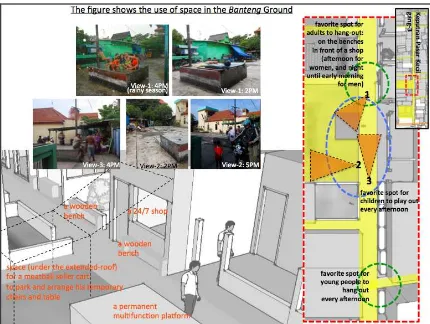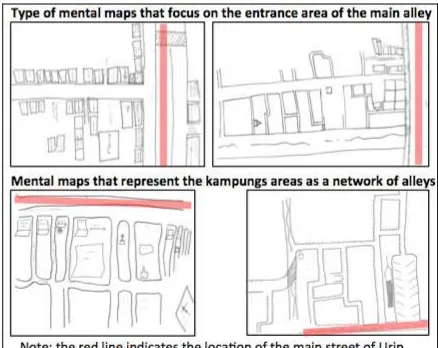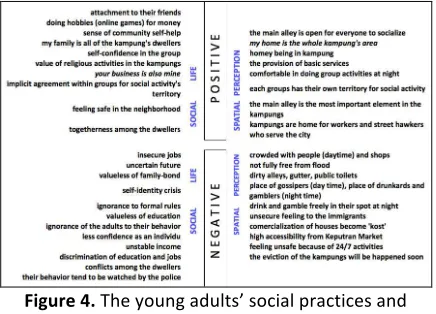YOUNG ADULT’S PERCEPTIONS OF SPATIAL IDENTITY IN KAMPUNGS, SURABAYA -‐ INDONESIA
Architecture Department, Petra Christian University, Surabaya -‐ Indonesia
4 which covers perception and conception. This article explores young adults’ perception and identity in facing the modernity contrast of kampungs and the city (kampung = urban village), in order to suggest public policies in improving the spatial environment. It is based on a qualitative research with young multifaceted methodological approach, combined
Perception is a mental representation of spatial identity or spatial knowledge (Tuan 1977), and creates a connection between the observers and the urban setting. There are a variety of ways to represent spatial perception; and mental map making is the most common way. According to Downs and Stea (2011), cognitive maps of mental map are the processes to understand human’s perceptions especially in spatial knowledge. The maps are composed of a series of transformations: acquired codes, memory stores, and recalls. This decode information are about the environment and its attributes in the human’s everyday spatial environment. It is affected by culture and the experiences of the observers through an interaction and attachment process between the people in the city, its urban elements, structural pattern of the city, and the observers’ imagination. The observers through their positive or negative, strong or weak perception of the setting define the degree of attachment that later identify the elements or spatial quality that make the observers attached to the setting.
Because this research relates to spatial identity development process behind a specific group, a semi-‐ethnographical approach is needed, and it allows the researcher to interpret the meaning of the thematic findings (Dillabough and Kennelly 2010). The methods used in this research are a combination of Kevin Lynch’s techniques in his books ‘Image of the City’ (Lynch 1960) and ‘Growing Up in Cities’ (Lynch 1977), and also ethnographical research methods from other studies related to young people living in marginal areas (from Chawla 2002 and Soja 1996). Lynch’s concept focuses on the ‘material types’ of spatial identity expression, because it is emphasizing on legibility factor that is a physical value of elements/urban spaces. Through the exploration of the society in their social life in ethnographical approach, the observation of other types of symbol bearers (iconic, behavioural, and discursive) could be identified.
SOCIAL LIFE
Participants in the research are young adults aged 20-‐26 years old, and who have lived in kampungs since they were born. This research considered young adults who have settled in two kampungs: the kampung of Keputran Pasar Kecil and Kedondong, which are located around the business district of Surabaya, the area of Basuki Rahmad. On average, they continued their education until high school, and some of them finished college; they work in casual basis whether in their kampungs or in the city.
Time Allocation and Activities
Figure 1. Time Allocation and Activities
According to the time allocation diagram, a small number of the participants are earning money for living from outside the kampungs in formal institutions. They have a flexible daily schedule, because they are jobless or work from home or work on a casual basis. Some of them have shops in their houses running by the family members, hence they have to wake up early morning to prepare foods/ drinks and pack them. At a particular time of day, they are responsible for taking care the shop while relaxing with their friends in the shop. Most of them have casual jobs; therefore their leisure time is relatively high compared to those who work in formal institutions. Their daily schedule depends on their working time, but for those who have casual work or are jobless, they do hang out1 in the kampung almost every day until early morning around 3AM.
Figure 2. Spots of social activities in the kampungs
The participants spend most of their daily time in the kampungs, whether for work or relaxing with
1
friends. Activities at the weekend show that they like to spend their holidays in the kampung in particular spots regularly. Often they continue to drink and gamble. The best time to experience the young adults’ life is in the afternoon until late evening. There were no extraordinary activities in the morning, but later in the afternoon, when the sun is getting low, the kampung’s main alley becomes crowded. Young adults’ favourite places to gather in the kampung of Kedondong are around the corner close to a barber shop, snacks/ food shop, and one – room dwellings around the corner; and in the kampung of Keputran in front of a cyber café that is located near the entrance gate and facing the Mushalla ground (an open space).
In the kampung of Kedondong, people of many ages like to chat, play, smoke, eat afternoon snacks, drink coffee or just sit along the corner, especially in the afternoon. Children are playing around the alley, while some small children are dressed by their moms in front of their one-‐room dwellings after having their showers. Men and women chat in a very relaxed way. They make jokes, laugh at each other and sometimes talk about serious topics. While they converse they also drink and eat snacks provided by a shop. After Maghrib time (around 7pm), more young men in this area. Approaching midnight, some young men from outside the kampung come to gather in this area. One of them collects money from the others, and later buys alcoholic drinks from outside. It is not a legal alcoholic drink, but alcohol liquid (illegal brewing) mixed with energy drinks or sodas. At around 2AM; they finished their drinks, some left the kampung, some could not even stand up and keep lying on the floor until the early morning. Adults just watched them from distance and continued with their chatting and chess games. Sometimes, the young adult had brawls until the elders stop them and asked them to leave the area.
SPATIAL PERCEPTION
Spatial perception analysis is based on data from mental map drawings to show their imageability to the neighbourhood, and also questions related to their favourite places, disliked places and changes in their neighbourhood.
The Image of The Kampungs
Exploring the young adults’ mental maps of the kampungs, the spatial/elements preferences in the kampung emphasized along the main alley, which is the only access to the kampung. They know most of the details: the number of houses, colour of the benches, trees and greenery; and also members of
groups that gather in specific areas. Particularly, they have strong preferences in areas along the alley especially the spots for meeting.
Figure 3. Kampungs Images by the young adults
According to interviews with the young adults regarding the best words conceptualized their kampungs, they had mentioned several important points, which are:
-‐ Simple place in a strategic location -‐ Place of nice and friendly people -‐ Crowded and never quiet
-‐ Claustrophobic and a lot of shops
-‐ Place for young people with no future, gamblers and drunkards, and jobless people
-‐ Place for gossipers
The Favorite Places
In defining favourite places in the kampung, has been asked several questions related to places: what they spend most of their time, what are the most important places in the kampung, what are the best places for social activity, and what is the best place in the kampung. In both kampungs, young adults mentioned their homes as places where they spend most time and the most important place in the kampung, and then they mentioned the cyber café and the shop-‐corner mentioned previously. In both locations, they spend their leisure time relaxing with friends. Besides both locations, they also mention the Mushalla and Banteng Ground as their favourite places for social activity.
“My favourite place in this kampung is the cyber café, it is the place where I can play with my friends, work to earn money and kill my time. We like to sit on the bench for hours just to chat and watch people passing by until morning” (male, 26 years old)
Surprisingly, when asked about their hope for their kampungs, mostly said that there will be no hope for the kampungs since it will be demolished by the government and change into commercial areas expanding the business district. In the future they are sure that the kampungs will be worse in terms of the environmental quality and the density. Even though they feel uncertain about the future, they still want to stay in the kampungs. When asked them about leaving the kampung in the event of them having enough money, they said no except to move to new places with their friends, and some said that they would prefer to open a business in the kampung rather than buy a new house in any formal settlements. The important values of the strategic location of their kampung which is attached to the central business district, is very crucial to them and it is not replaceable. They feel no urgency to move to a better settlements area. Even for some adults who have their second house in a formal estate far from the city centre, they prefer to stay in kampung. Attachment of young adults to their friends is strong, stronger than their attachment to the kampungs, and the value of the strategic location of the kampung is also something to keep.
“I don’t want to think about the future, I have never had an opportunity to have a good career; recently, I’m just doing what I can: earning money, spending money, and playing with my friends; this is my life”
(male 26 years old)
When discussed the experience of living in a kampung, the young adults had highlighted several points that they felt were important, which are: we have enough room to do our activities; we feel comfortable being here, we feel safe enough and yet we feel crowded. Their feeling is in paradox: crowded but comfort and free. They understood that kampungs are the populous areas; but living in these kampungs since they were born, they get used to the crowds, and never feel uncomfortable. From time to time; they said that parents, families and friends said it was very rare to have the opportunity of a good career. Therefore, they felt hopeless about their future, being in a kampung is a fate, no need to regret and it is better to enjoy the life.
CONCLUSION: SPATIAL IDENTITY
In answering questions raised on the first part of this article: What does it mean to be young and live in marginal areas of kampungs that is in juxtaposition to a central business district? Is there any specific spatial perception and identity that are crucial for public policy in protecting this area?. The first question is answered through the exploration of the
young adults’ social practices, and the second question through the spatial perception exploration of the spatial image, favourite place, disliked/worst places and change and hopes. This section is the analysis of spatial identity identification based on the both findings; it is summarized in the diagram below.
Figure 4. The young adults’ social practices and spatial perception
The diagram shows two groups in spatial identity development through place attachment study ( adopted from Chawla 2002): social life (left side), and spatial perception (right side). These groups has dimension in positive and negative correlations. This analysis also explores place alienation through negative feeling of social life and spatial perceptions to the environment (through the negatives dimension).
It could be summarized that the spatial identity are developed through social bonding, feeling of security/insecurity, feeling of territoriality, spatial recognition, sense of community, and sense of life stability. Referring to the four types of spatial identity expression, the spatial identity of the young adults to their kampungs are explained below, however there is an absent of discursive symbols: -‐ Material identity is reflected through the organic
pattern of the alleys and houses, one-‐room dwellings, and places/ spots for hang out.
-‐ Iconic identity is reflected through the alleys as a social space, places of worship, the ancestor’s graves, and the kampungs’ gate
-‐ Behavioral identity is reflected through the young adults social activity in the spot related to their hobby that connect them to modernity in virtual life, such as the cyber café.
conception of the young adults to their kampungs, the crucial identity does not refer to the physical
elements that common planning strategy
acknowledged. Therefore in urban planning strategy, the socio-‐anthropological approach is important especially in analysing urban areas in marginal position such as kampungs.
The main purpose of this study is to suggest public policies in improving the spatial environment. Today, kampungs’ development and empowerment is rarely answering young adults’ needs. On the other hand, Petra Christian University Surabaya-‐ Indonesia.
Colonial to Independence Era). Yogyakarta: Ombak. London: UNESCO Publising, Earthscan Publication. Ohio University Center for International Studies.
Dillabough, Jo-‐Anne, and Jacqueline Kennelly. 2010. Lost Youth in The Global City: Class, Culture Mapping Practice and Cartographic Representation, edited by Martin Dodge, Rob Kitchin, and Chris Perkins. John Wiley & American Cities. Middlesex: Penguin Books. Kresno Murti, Yoshi Fajar. 2011. “‘Babad Kampung’
from Yogyakarta: Unfinished Story of Contesting Identities and Creating
Negotiations Space on the History of Urban Development.” In Kampung Perkotaan: Kajian Historis-‐Antropologis Sosial Dan Ruang Kota (Urban Kampung: The History and Anthroplogy of Society and Urban Space). Surabaya: Australia-‐Netherlands Research Collaboration (ANRC),
Departemen Ilmu Sejarah Universitas Airlangga, Elmatera Publisher. Spatial Environment of Adolescent. Cambridge Paris: MIT Press UNESCO. Nas, Peter J.M. 1993. “Introduction: Urban
Symbolism.” In Urban Symbolism, edited by Peter J.M. Nas. Vol. 8. Studies in Human Society. Netherlands: E.J. Brill.
———. 2002. “Introduction:The Indonesian Town Revisited.” In The Indonesian Town Revisited, edited by Peter J.M. Nas. Singapore: Institute of Southeast Asian STudies (LIT Verlag).
Proshansky, Harold, Abbe Fabian, and Robert Kaminoff. 1983. “Place Identity: Physical World Socialization of the Self.” Journal of Environmental Psychology 3: 57–83. Shamsuddin, Shuhana, and Norsidah Ujang. 2008.
“Making Places: The Role of Attachment in Creating the Sense of Place for Traditional Streets in Malaysia.” Habitat International Elsevier 32: 399–409.
Soja, Edward. W. 1996. Thirdspace; Journeys to Los Angeles and Other Real-‐and-‐Imagined Places. Oxford: Blackwell Publisher. Tuan, Yi Fu. 1977. Space and Place: The Perspective
and Experience. London: Edward Arnold.


